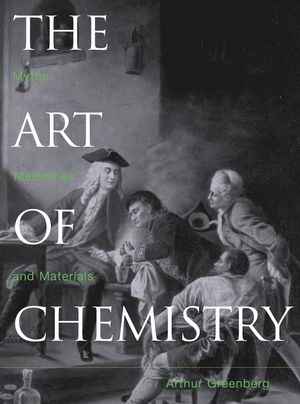The Art of Chemistry: Myths, Medicines, and MaterialsISBN: 978-0-471-07180-8
Hardcover
400 pages
December 2002
 |
||||||
"This book may give you cause to brag about your knowledge…" (Chemist, April 2004)
“Yes, Virginia, chemistry can be funny and Greenberg has given us a masterful presentation. This book is recommended for academic and public library collections (and should be read by all chemistry majors).” (E-Streams, Vol. 7, No. 3)
"...a truly fascinating survey and inquiry...very highly recommended..." (Library Bookwatch, January 2003)
"...The Art of Chemistry is well written and peppered with Greenberg's witty comments...The more of the book I read, the more I kept on wanting to read..." (Nature, 20 February 2003)
"...a companion to Arthur Greenberg’s earlier book...again he offers us a selection from his unique collection of historical material. If you enjoyed the earlier book, which I did, you will enjoy this as well...lavishly illustrated...well written and peppered with...witty comments and cynical asides..." (Nature, Vol. 421, February 20, 2003)
..."If you want to be diverted and occasionally surprised, enquire within..."(Chemistry in Britain, March 2003)
"...The book is certainly entertaining, both visually and intellectually..." (The Alchemist – ChemWeb, 2 April 2003)
"...recommended..." (Library Journal Reviews, March 15, 2003)
"...Arthur Greenberg leads us on an eclectic and very personal romp…in 72 short essays accompanied by nearly 200 illustrations…we follow an erratic but fascinating route through the history of chemistry..." (New Scientist, February 1, 2003)
"...a rousing sequel to A Chemical History Tour...this large-format work packs in even more visual treats while romping through chemical history..." (Bulletin for the History of Chemistry, 2002)
Mentioned with another title Transmutations: "...explores how artists and scientists have depicted the principles, practitioners, and apparatus of chemistry...an episodic and very idiosyncratic history of chemistry..." (American Heritage of Invention & Technology, Spring 2003)
"...suitable as a gift for either a chemist or a...student...or as a reference book for a chemistry teacher...a useful visual compendium…captures the joy of collecting chemical images..." (Journal of Chemical Education, June 2003)
"...a very interesting mix of information...an interesting treatise on one facet of scientific progress." (Science Books & Films, June 2003)
"...The book has an undoubted charm". (Times Higher Educational Supplement, 4 July 2003)
"....It has been a pleasure to read this book and then browse extensively through it. It is not only a read for ancients like me, it could also inspire more young people to believe that chemistry makes and interesting life's work and study..." (Chemistry & Industry, 21 July 2003)
"...highly entertaining and informative..." (The Chemist, Summer 2003)
"...the reader follows the author...with interest and pleasure...due not only to the clever way in which this immense amount of historical material has been arranged, but also to his talent as a storyteller. To learn something important in a short time and in an amusing way-what more could one wish for?" (Angewandte Chemie, International Edition, Vol. 42)
"...there is material here in plenty for the chemist and bibliophile as well as for the 'amiable historian'...Idiosyncratic, self-indulgent, and even corny, Greenberg believes chemistry to be fun. It is much to be hoped that The Art of Chemistry like A Chemical History Tour, will find its way into school and college...and encourage a new generation of students to laugh all the way to the lab." (Chemical Heritage, Vol. 21, No. 3, Fall 2003)
"Greenberg's book should be in every library...available not only to chemists but to anybody who is interested in the history of science...it should find an honored place on the coffee table of every chemist.... The author is to be congratulated having painstakingly researched and lucidly written this fascinating book..." (Synthesis and Reactivity in Inorganic and Metal-Organic Chemistry, Vol. 33, No. 9)
"Although the primary reason for buying this book is its artistic content and artwork, the forward motion to explain the transformation of myths, superstitions, and their application to the arts and medicine into modern science as we know it will captivate readers." (Clinical Chemistry, Vol. 49, No. 12)



